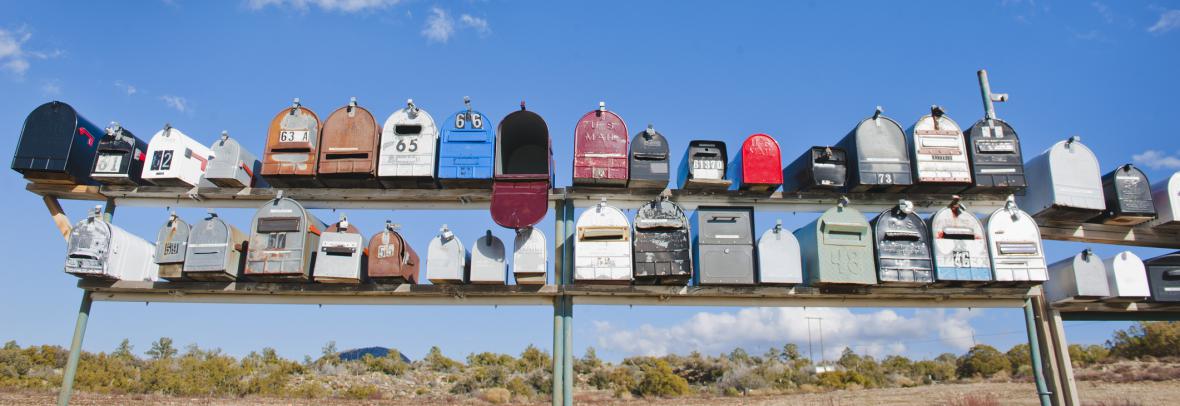
Using Direct Mail Marketing Services for Sales
Direct mail marketing can connect agents with customers through tangible items like letters, flyers and branded gifts to boost engagement and ROI.
NEW YORK — Direct mail marketing services are a simple and effective way for marketers to connect with their target audience. Postal marketing gets a tangible item into the hands of the consumers who matter most to you, which leads to a high overall ROI.
In fact, Data Axle USA reported that 62% of people who respond to direct mail also make a purchase. There's no reason to shirk that figure.
Here, we'll discuss the ins and outs of mailing solutions and how using them can amplify your customer engagement strategies. Learn how you can create and print materials that will take your business to the next level.
What is direct mail marketing?
Direct mail marketing services involve sending physical marketing materials to potential clients and customers. Some of these mail pieces may include:
- Letters
- Flyers
- Pamphlets
- Postcards
- Catalogues
- Magazines
They go directly to the recipient's home or business address, making them easy for your lead to access.
Direct mail marketing gives the person you're advertising to a physical item to connect with. It's a tangible brand experience that stands out in a digital world. People will understand that they were singled out for a special marketing job and know that your business cares about them and their specific needs.
Does direct mail advertising still work?
According to 2025 Postalytics statistics:
- Direct mailing solutions have an average ROI of 35%
- 71% of people feel like direct mail is more personal than online interactions
- 84% of marketing teams say that direct mail has the highest ROI of all their marketing channels
- 85% of marketers say that direct mail offers the best conversion rates
This shows that, yes, direct mail marketing still is relevant. Many consumers also have positive feelings toward direct marketing because it isn't disruptive. There's nothing more annoying than going online and being bombarded with ads, and it can decrease your brand's image in the eyes of customers. Direct mail doesn't create this annoyance, and it replaces irritating ads with the fuzzy feelings that accompany getting something cool in the mail.
Direct mail can also include merchandise and care packages with branded items, such as:
- Pens and pencils
- Mugs
- Tote bags
- T-shirts
- Patches
- Buttons
When people get these objects, they won't just feel like you made an effort for them. They'll also experience the joy of getting a gift that they can use for a long time.
How to print and distribute promotional materials
For many businesses, printing and distribution are the hardest steps of direct mail marketing. Printing quality items requires industry-grade printers and quality paper. If you're trying to send out a non-traditional promotional item like a T-shirt or baseball cap, printing it might prove impossible.
Distribution also poses organizational challenges. Mailing lists usually consist of several hundred people, and it's hard to keep their names and addresses straight. If you have a segmented audience with customers that have distinct pain points, it gets even harder to pair the right materials with the appropriate people.
Fulfillment services will format your designs to fit the right marketing materials. Whether you want a banner or wide-format printing, they have your back. Special effects can also enhance your marketing campaign, like edge painting or metallic ink.
FAQs
What business types reap the most benefits from direct mail marketing services?
Most businesses can benefit from direct mail advertising, but those with smaller target audiences usually reap the most benefits. This is because mail can go out to a smaller number of people and make the highest possible impact since everyone will be within your target audience.
Local businesses also see more business with Every Door Direct Mail (EDDM) advertising. This delivers marketing materials to everyone within a certain postal code. Those who have access to your physical location will learn about you, which drives foot traffic to smaller shops and offices.
How can marketers decide who receives targeted advertising?
If your target audience isn't within a single area, you'll need to research your target demographics. This means:
- Looking at who has bought your products most frequently
- Using cookies to see the demographics of those who browse your website
- Leveraging Google Analytics and related tools to see who's searching for your goods and services
- Tracking what online ads have led to the most conversions and emulating their color schemes and selling points
- Creating charts and graphs to visualize data more easily
Jot down consumers':
- Ages
- Genders
- Occupations
- Income
- Pain points
- Values
Then, you can create a buyer persona (or multiple personas) to sell your materials to. Send the direct mail marketing materials to the people who best match them.
Can marketers integrate physical marketing with digital strategies?
Yes, physical marketing materials can go hand in hand with your digital campaigns. Put a QR code on the back of each flyer or brochure you send out. Let recipients know that scanning it will take them to a page that you talked about in the printed material.
You could also take them to a landing page with a contact form if that's the type of conversion you're looking to generate.
Boost customer engagement strategies today
From targeted advertising to no-frills formatting, direct mail marketing services are beneficial to businesses in all industries.
Now that you know how to make the most of your postal marketing campaign, it's time to dive deeper into advertising ideas that will make your business stand out from the competition.
© Copyright, 2025, The Coeur d'Alene Press. All rights reserved.
